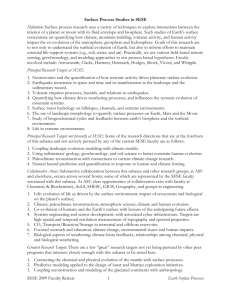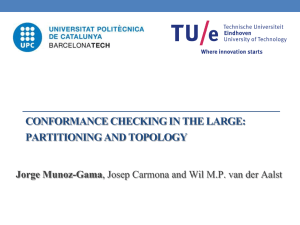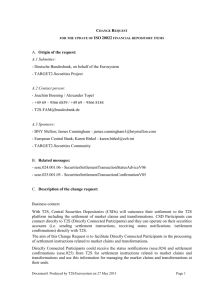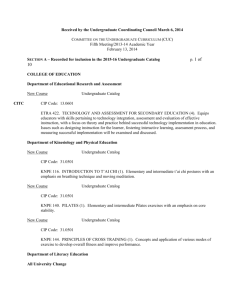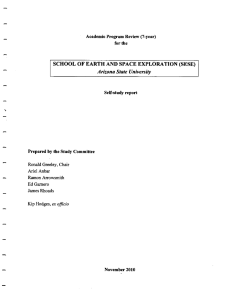Wind Energy Collection for SESE
advertisement
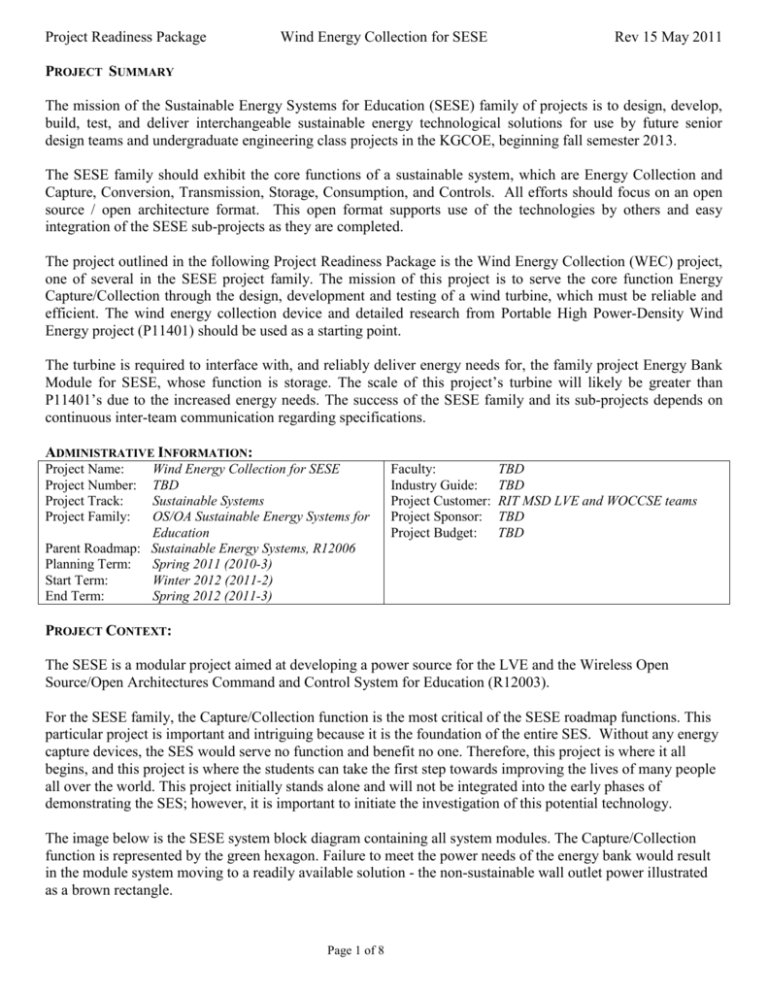
Project Readiness Package Wind Energy Collection for SESE Rev 15 May 2011 PROJECT SUMMARY The mission of the Sustainable Energy Systems for Education (SESE) family of projects is to design, develop, build, test, and deliver interchangeable sustainable energy technological solutions for use by future senior design teams and undergraduate engineering class projects in the KGCOE, beginning fall semester 2013. The SESE family should exhibit the core functions of a sustainable system, which are Energy Collection and Capture, Conversion, Transmission, Storage, Consumption, and Controls. All efforts should focus on an open source / open architecture format. This open format supports use of the technologies by others and easy integration of the SESE sub-projects as they are completed. The project outlined in the following Project Readiness Package is the Wind Energy Collection (WEC) project, one of several in the SESE project family. The mission of this project is to serve the core function Energy Capture/Collection through the design, development and testing of a wind turbine, which must be reliable and efficient. The wind energy collection device and detailed research from Portable High Power-Density Wind Energy project (P11401) should be used as a starting point. The turbine is required to interface with, and reliably deliver energy needs for, the family project Energy Bank Module for SESE, whose function is storage. The scale of this project’s turbine will likely be greater than P11401’s due to the increased energy needs. The success of the SESE family and its sub-projects depends on continuous inter-team communication regarding specifications. ADMINISTRATIVE INFORMATION: Project Name: Project Number: Project Track: Project Family: Wind Energy Collection for SESE TBD Sustainable Systems OS/OA Sustainable Energy Systems for Education Parent Roadmap: Sustainable Energy Systems, R12006 Planning Term: Spring 2011 (2010-3) Start Term: Winter 2012 (2011-2) End Term: Spring 2012 (2011-3) Faculty: Industry Guide: Project Customer: Project Sponsor: Project Budget: TBD TBD RIT MSD LVE and WOCCSE teams TBD TBD PROJECT CONTEXT: The SESE is a modular project aimed at developing a power source for the LVE and the Wireless Open Source/Open Architectures Command and Control System for Education (R12003). For the SESE family, the Capture/Collection function is the most critical of the SESE roadmap functions. This particular project is important and intriguing because it is the foundation of the entire SES. Without any energy capture devices, the SES would serve no function and benefit no one. Therefore, this project is where it all begins, and this project is where the students can take the first step towards improving the lives of many people all over the world. This project initially stands alone and will not be integrated into the early phases of demonstrating the SES; however, it is important to initiate the investigation of this potential technology. The image below is the SESE system block diagram containing all system modules. The Capture/Collection function is represented by the green hexagon. Failure to meet the power needs of the energy bank would result in the module system moving to a readily available solution - the non-sustainable wall outlet power illustrated as a brown rectangle. Page 1 of 8 Project Readiness Package Wind Energy Collection for SESE Rev 15 May 2011 As mentioned in the summary, this project should use Portable High Power-Density Wind Energy project as a starting point, please visit http://edge.rit.edu/content/P11401/public/Home. Also for more information on the larger project into which this system will be integrated, please visit http://edge.rit.edu/content/R12006/public/Home Page 2 of 8 Project Readiness Package Wind Energy Collection for SESE PROJECT HOUSE OF QUALITY: Page 3 of 8 Rev 15 May 2011 Project Readiness Package Wind Energy Collection for SESE CUSTOMER NEEDS ASSESSMENT: Page 4 of 8 Rev 15 May 2011 Project Readiness Package Wind Energy Collection for SESE ENGINEERING SPECIFICATIONS: Page 5 of 8 Rev 15 May 2011 Project Readiness Package Wind Energy Collection for SESE Rev 15 May 2011 PROJECT INTERFACES: Integral to the success of this project is its ability to easily connect to the systems being produced by other senior design teams. That said, the major interface of this project requires that the Wind Turbine convert its collected wind energy to DC voltage form. The project electronic conversion goal is 90% efficiency. Specifically, it should output power from one female Molex connector to a different male Molex connector on the Energy Bank Regulation board. NOTE: The Capture/Collect team will need to communicate with the Energy Bank team to the pin count which will be based on the power that the Capture/Collection team can supply. STAFFING REQUIREMENTS: Position Title Position Description Individuals will lead the design, development, and testing of a wind turbine for a specified power output. The challenge is that the turbine’s size, location, generator selection, material selection, and circuitry must be researched and optimized for a reliable and efficient system. Mechanical Engineer – Design (2 student) Mechanical Engineer – Fabrication Specialist (1 student) Mechanical Engineer Modeling Software (1 student) Individuals should be pursuing a degree in Mechanical Engineering and should be familiar with the machine shop tools and equipment. Some experience in the EE field through co-ops or additional coursework is preferred. Fluid Mechanics, System Dynamics, experience is preferred. Interest in sustainability and renewable energy would be beneficial. Required coursework: Circuits I, Materials Processing, Design of Machine Elements, Mechanics and Engineering Design Graphics. This individual will be responsible for fabricating most of the wind turbine’s components such as the hub assembly, boom, and stand. The challenge will be to make the system secure and robust, as well as work under a broad range of environmental conditions. Individuals should be pursuing a degree in Mechanical Engineering. Interest and experience with metal fabrication is crucial for success. Must understand fluid dynamics. Interest in sustainability and renewable energy would be beneficial. Required coursework: Circuits I, Materials Processing, Design of Machine Elements. This individual will assist with the wind turbine design by modeling load, stress, deflection, and thermal effect through vital components in the system, such as bearings and gears, to insure the system is secure, reliable and efficient throughout the broad range of conditions it is exposed to. Individuals should be pursuing a degree in Mechanical Engineering and should be familiar with the machine shop tools and equipment. Comfortable use of ANSYS and ProEngineer is crucial. Required coursework: Circuits I, Materials Processing, Design of Machine Elements, Engineering Design Graphics, and Advanced Computational Techniques. Page 6 of 8 Project Readiness Package Industrial Engineer – Interface Manager (1 potentially) Wind Energy Collection for SESE Rev 15 May 2011 This individual will have three key responsibilities: The first will be to act as a liaison to the other SESE module teams as well as the LVE and the WOCCSE projects; secondly, this individual should perform a thorough cost-benefit analysis to determine the return on investment of the prototype as well as a mass manufactured system. Due to the sustainability aspect of this project, this individual will complete life-cycle assessment and provide recommendations for material use and end-of-life options. Experience with project management and sustainability is preferred. Interest in sustainability and renewable energy will be beneficial. Required coursework: Engineering Economy, Life Cycle Assessment, Design for Environment, Engineering Management, Design for Project Management. PROJECT CONSTRAINTS: Regulatory Constraints The design shall comply with all applicable federal, state, and local laws and regulations. The team's design project report should include references to, and compliance with all applicable federal, state, and local laws and regulations (see ISO Standards for Energy Collection) The design shall comply with all applicable RIT Policies and Procedures. The team's design project report should include references to, and compliance with all applicable RIT Policies and Procedures. Economic Constraints Each team will be required to keep track of all expenses incurred with their project. Purchases for this roadmap will be run through the Mechanical Engineering Office. Each team must complete a standard MSD purchase requisition and have it approved by their guide. After guide approval, the purchasing agent for the team can work with Ms. Venessa Mitchell in the ME office to execute the purchase and obtain the materials and supplies. Environmental Constraints Adverse environmental impacts of the project, such as the release of toxic materials or disruption of the natural wildlife, are to be minimized. Particular focus should be placed on resource sustainability (described further in Sustainability Constraints). Material Safety Data Sheets (MSDS) are required for all materials. Social Constraints Each team in this roadmap is expected to demonstrate the value and outcome of their project at the annual Imagine RIT festival in the spring. Ethical Constraints Every member of every team is expected to comply with Institute Policies, including the Policy on Academic Honesty, and the Policy on Academic Accommodations. Health and Safety Constraints Wherever practical, the design should follow industry standard codes and standards (e.g. Restriction of Hazardous Substances (RoHS), FCC regulations, IEEE standards, and relevant safety standards as prescribed by IEC, including IEC60601). The team's design project report should include references to, and compliance with industry codes or standards. Manufacturing Constraints Commercially available, Off-The-Shelf (COTS) components available from more than one vendor are preferred. It is preferable to manufacture and assemble components in-house from raw materials where feasible. Page 7 of 8 Project Readiness Package Wind Energy Collection for SESE Rev 15 May 2011 Students should articulate the reasoning and logic behind tolerances and specifications on manufacturing dimensions and purchasing specifications. Intellectual Property Constraints All work to be completed by students in this track is expected to be released to the public domain. Students, Faculty, Staff, and other participants in the project will be expected to release rights to their designs, documents, drawings, etc., to the public domain, so that others may freely build upon the results and findings without constraint. Students, Faculty, and Staff associated with the project are encouraged to publish findings, data, and results openly. Students, Faculty, and Staff associated with the project are expected to respect the intellectual property of others, including copyright and patent rights. Sustainability Constraints All raw materials and purchased materials, supplies, and components used in the roadmap must have a clearly defined Re-Use, Re-Manufacturing, or Recycling plan. This is intended to be a "Zero Landfill" project. This includes documents as well as project materials. Each team in the project family is limited to no more than 150 pages of printed documentation during MSD1 and MSD2 (not including the MSD2 poster and MSD2 technical paper). Teams may use an unlimited amount of electronic documentation, unless disk space becomes limited on the server. Each team must prepare an MSD2 poster and technical paper which is exempt from the paper constraint above. REQUIRED FACULTY / ENVIRONMENT / EQUIPMENT: Category Source Faculty RIT EE/ME Departments Environment RIT, Lab or MSD Floor Equipment RIT EE/ME Departments Materials Online and Local Suppliers Description Faculty expertise from each department for consulting. Expertise in power conversion (EE), metal fabrication (ME), fluids, solid modeling software, and sustainability is preferable. A dedicated space to work, safely store large project materials, and test equipment. An open area/field for operations and testing. Labs containing modeling software and hardware for designing, building and testing the system’s components. Fabrication equipment (ME machine shop). Sheet Metal, Metal Stock, Electrical Components, Wires, Connectors, Circuit Boards. Other Page 8 of 8 Resource Available (mark with X) X X X
